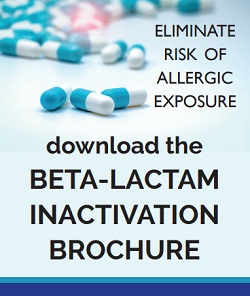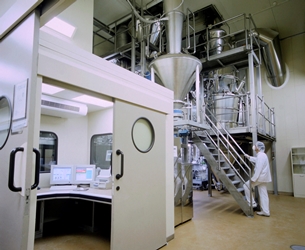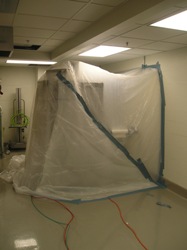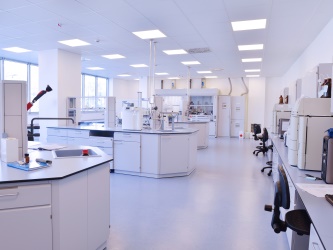- Quick Links
- Articles
- Decon Services
- Products
- In-Person Workshops
- Webinars
Applications

Since 2006, ClorDiSys has been helping pharmaceutical companies treat equipment and environments containing beta-lactams such that
they may be repurposed for non-beta-lactam use. This service has helped the industry reduce waste and save money as equipment and facilities would be
abandoned and demolished in the past. Utilizing a chlorine dioxide gas process tested and verified to be effective, we’ve helped treat environments
ranging from an empty 2,500 ft3 laboratory all the way up to a fully furnished 4-story building inclusive of ductwork and mechanical spaces.
While ClorDiSys has successfully tested chlorine dioxide gas against numerous beta-lactams, we typically suggest performing validation
runs prior to an environmental treatment. Many beta-lactams differ from one another and should be tested to ensure success. Previous
beta-lactam inactivation testing has been performed by LCMS Limited, an independent 3rd party laboratory.
Initial Beta-Lactam Testing

The goal of the initial testing was to achieve a 3-log reduction of beta-lactams for the repurposing of equipment used in beta-lactam production. Chemical indicators were manufactured by the research laboratory and consisted of impregnating a cocktail of eight types of beta-lactams onto three different carrier materials. Chosen due to their prevalence in the manufacturing and laboratory environments, carriers were made out of polycarbonate plastic (lexan), stainless steel (304 L, passivated), and aluminum (non-anodized). A single square-profiled channel approximately 0.5 - 1.0 mm deep and wide was machined lengthwise along the center on one side of each coupon to simulate the presence of beta-lactam residues in cracks and crevices. The eight beta-lactams tested against were chosen to represent a sampling of those on the equipment driving the study as well as some other common beta-lactams. They consisted of beta-lactams from the penicillin group (Penicillin G, Penicillin V, and Ampicillin), the cephalosporin group (Cefadroxil, Cefazolin, and Cephalexin), and carbapenum group (Imipenem).
Case Studies
A four-story, 570,000 ft3 fully furnished beta-lactam production building was being repurposed to produce a different, non-beta-lactam product. Chlorine dioxide gas treatment was employed in order to ensure safe production of the new antibiotic. The whole building was treated over the course of 3 days (setup on Day 1-2, treatment and cleanup on Day 3) including its ductwork and mechanical space. Post-treatment swab testing showed zero recoverable beta-lactams, and the new production process was allowed to begin.
 |
 |
One of the first commercial applications for beta-lactam inactivation was the treatment of used equipment being removed from
a beta-lactam production facility. The equipment was pulled out and placed into a trailer for chlorine dioxide gas treatment. Chlorine dioxide
gas treatment took 7 hours from start to finish. Upon completion, swabs were taken to ensure that no beta-lactams could be recovered. After
clearance, the trailer was brought to the new destination where the equipment could be safely installed without the risk of cross-contamination.
Equipment can also be treated by tenting it within a room/warehouse, or it can be shipped to our facility for treatment.
 |
 |
A 2,500 ft3 laboratory space had a fermenter contaminated from previous beta-lactam R&D work. Rather than simply treat the fermenter, the facility decided it was safer to treat the whole laboratory in case the contamination was elsewhere too. After sealing the laboratory off from the adjoining spaces, it was treated with chlorine dioxide gas. Over the course of 12 hours, the entire project was completed from setup to cleanup. Post-treatment swabs came back negative for the beta-lactam, and the laboratory was able to use the fermenter once again.
 |
 |

The CD Gas Advantage
- ClorDiSys' CD Gas is an EPA registered sterilant, making it effective against all viruses, bacteria, fungi and spores
- Non-carcinogenic, residue free process
- True gases are the only agents effective in hard to reach areas such as HVAC systems, cracks and crevices, and inside equipment.
- Gaseous CD is the only decontaminating fumigant that penetrates water, decontaminating both the water and the surface beneath.
- Safe on materials such stainless steel, anodized aluminum, painted steel, plastics, epoxy flooring and paints, gasket materials, and electronics
